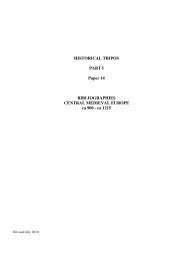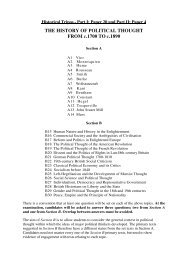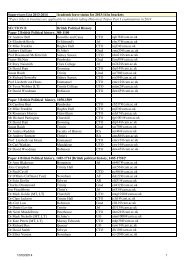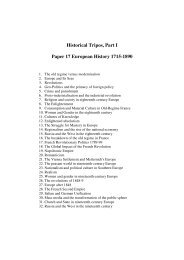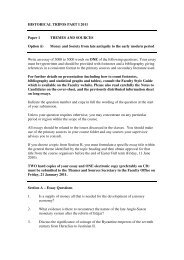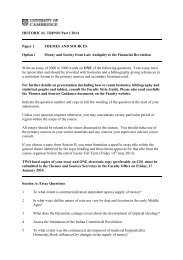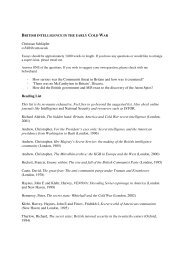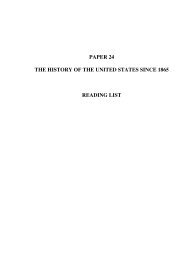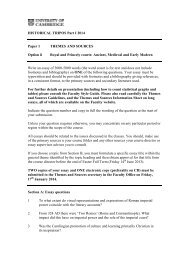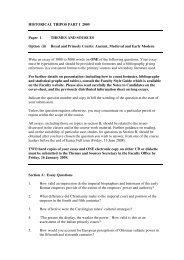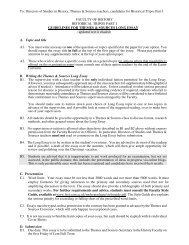Course Handbook - Faculty of History - University of Cambridge
Course Handbook - Faculty of History - University of Cambridge
Course Handbook - Faculty of History - University of Cambridge
Create successful ePaper yourself
Turn your PDF publications into a flip-book with our unique Google optimized e-Paper software.
APPENDIX B:<br />
MPHIL IN ECONOMIC AND SOCIAL HISTORY – MARKING AND EXAMINATION<br />
SCHEME<br />
1. SUMMARY OF THE COURSE STRUCTURE<br />
Part I (40%)<br />
a. Central Concepts and Problems in Economic and Social <strong>History</strong> and Theory (10%)<br />
b. Research Methods <strong>Course</strong> (10%)<br />
Social Science Research Methods <strong>Course</strong> (6%)<br />
Dissertation Proposal Essay (4%)<br />
c. Two Advanced <strong>Course</strong>s in Economic and/or Social <strong>History</strong> chosen from a specified list <strong>of</strong><br />
subjects (10% each).<br />
Part II (60%)<br />
a. A dissertation <strong>of</strong> between 15,000 and 20,000 words (including appendices and statistical tables,<br />
but excluding footnotes, references and bibliography) to be submitted at the end <strong>of</strong> August.<br />
2. THE MARKING SCHEME<br />
The criterion <strong>of</strong> judgment in determining pass in all MPhil examinations in <strong>Cambridge</strong> is the<br />
achievement <strong>of</strong> ‘the equivalent <strong>of</strong> an Upper Second Class in Part II <strong>of</strong> a Tripos, extrapolated for one<br />
year <strong>of</strong> graduate study’. Candidates are required to pass each course element and dissertation in this<br />
MPhil in these terms.<br />
The classification scheme <strong>of</strong> marking, expressed in percentage points, is as follows:<br />
75 and above Marks <strong>of</strong> 75 and above indicate a distinction<br />
67-74 Marks <strong>of</strong> 67 and above are strong marks <strong>of</strong> high II.1 or 1 st class quality<br />
which, ins<strong>of</strong>ar as essay marks are relevant, tend to support the case for<br />
leave to continue to the PhD<br />
63-66 Marks <strong>of</strong> 63 (the necessary mark for compensation: see Sections 10 & 12<br />
below) to 66 are solid but medium-range marks which will help the<br />
candidate securely to pass the course but may, as essay marks, raise<br />
questions about whether leave to continue to the PhD should be granted<br />
60-62 Marks <strong>of</strong> 60 to 62 are weak pass marks which indicate that the piece <strong>of</strong><br />
work deserves a bare pass in itself but is not strong enough to <strong>of</strong>fer<br />
compensating support should other work be <strong>of</strong> marginal fail quality<br />
59 Marginal fail mark<br />
58 and below Marks <strong>of</strong> 59 and below indicate work which falls below the academic<br />
standard <strong>of</strong> the course as set out above<br />
Note that ‘leave to continue’ to the PhD is judged primarily on the basis <strong>of</strong> dissertation performance,<br />
although strong performance in Part I can be taken into account in marginal cases.<br />
3. CRITERIA OF ASSESSEMENT<br />
Work at this level, particularly the dissertation, should reveal high standards <strong>of</strong> intellectual enquiry,<br />
research skills and analytical sophistication.<br />
Examiners should primarily assess the academic content <strong>of</strong> essays and the dissertation. They should<br />
consider scope (i.e. the appropriateness <strong>of</strong> the topic; its relation to a larger historical or theoretical<br />
18




